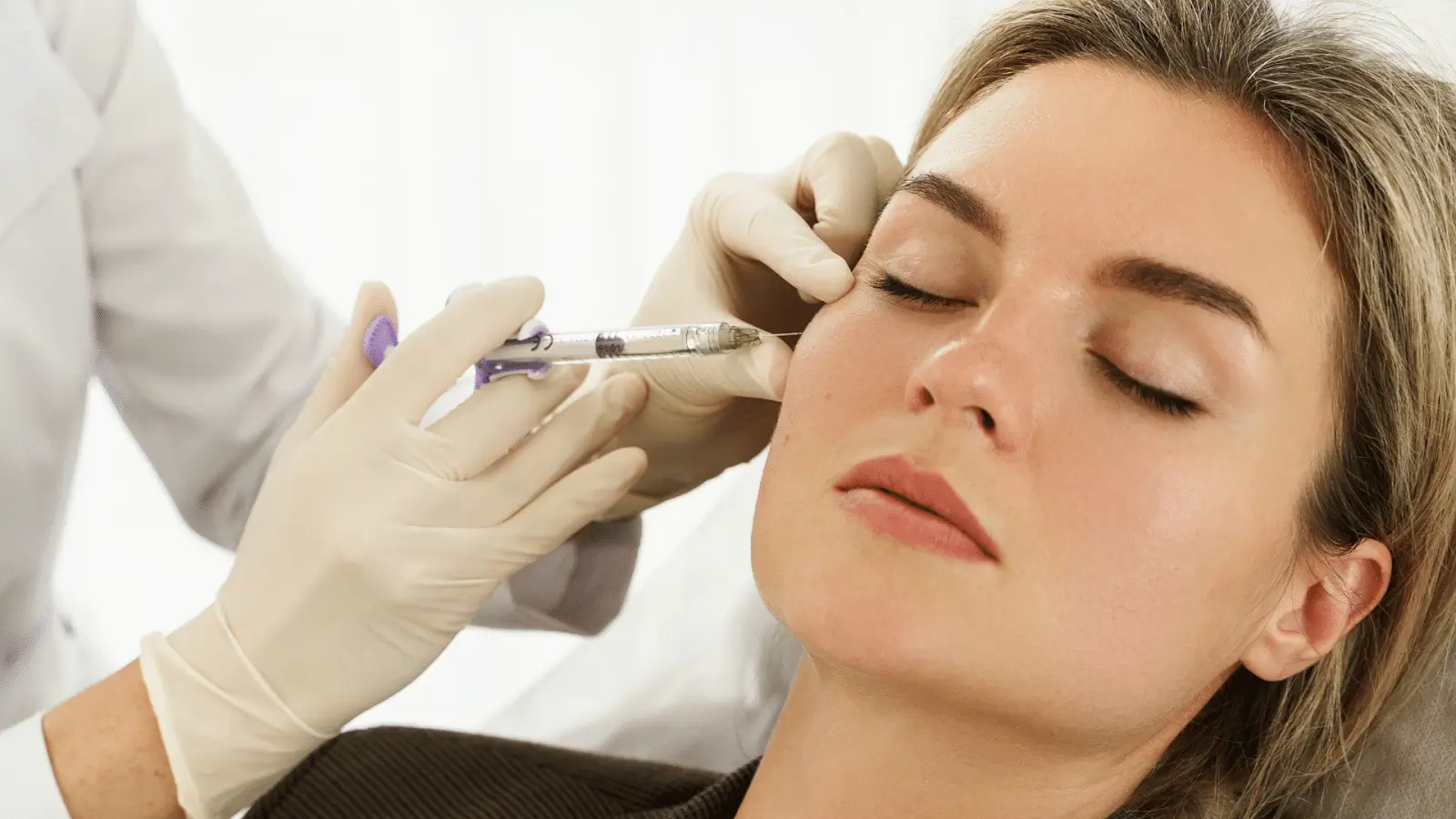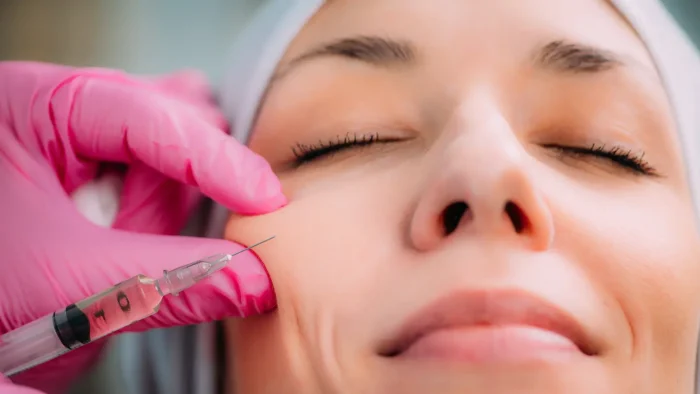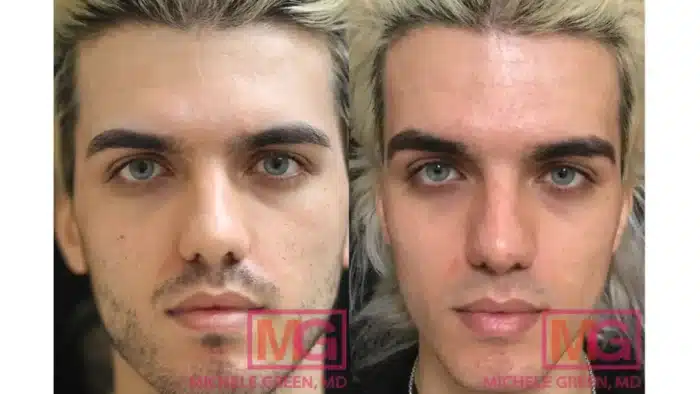
According to the International Society of Aesthetic Plastic Surgery (ISAPS), over 5.5 million hyaluronic acid filler procedures were performed in 2023—a 29% increase from the previous year. This surge shows a growing interest in minimally invasive treatments for facial rejuvenation.
With this trend rising, products like Harmonyca and Juvederm have caught attention for their unique formulations and impressive results. Both fillers aim to smooth lines, add volume, and enhance facial contours, but they differ in ways that might influence your decision.
In this article, we’ll compare Harmonyca vs Juvederm, breaking down their features, benefits, and potential drawbacks to help you decide which option suits your aesthetic goals.
Key Takeaways
- Harmonyca combines calcium hydroxyapatite (CaHA) and hyaluronic acid (HA) to stimulate immediate volume and long-term collagen, making it ideal for deeper skin rejuvenation.
- Juvederm uses hyaluronic acid (HA), which delivers fast results by plumping the skin and smoothing wrinkles. This makes it perfect for quick volume restoration and wrinkle reduction.
- Harmonyca is best for those seeking gradual improvements and long-lasting benefits, while Juvederm provides immediate results.
- Both fillers are safe, but Harmonyca may carry slightly higher risks of granuloma formation due to its CaHA component.
- Your choice between Harmonyca and Juvederm depends on your aesthetic goals, whether you prioritize quick fixes or long-term rejuvenation.
About: Doctor Medica is your trusted supplier of top-quality dermal fillers, viscosupplements, and more for your medical practice. We offer genuine products from leading brands at the lowest prices in the market. If you’re looking to order Harmonyca online for your practice, contact the Doctor Medica today.
Introduction to Harmonyca and Juvederm

Dermal fillers are injectable gels that help reduce wrinkles and add volume to the face, giving a more youthful appearance. Two leading options in this category are Harmonyca and Juvederm, each offering unique benefits.
Harmonyca is a newer type of filler that contains calcium hydroxyapatite. It not only adds volume but also stimulates collagen production, improving skin firmness over time. Unlike some other fillers, Harmonyca works on deeper layers of the skin, providing long-term benefits and helping the skin look firm and youthful.
Juvederm, on the other hand, is a well-known filler made from hyaluronic acid. It works quickly to smooth out wrinkles and add volume to the face, making it a popular choice for those who want fast, noticeable results.
Formulation and Composition

Harmonyca and Juvederm are both dermal fillers, but their formulations work in different ways. Harmonyca combines calcium hydroxyapatite (CaHA) and hyaluronic acid (HA). The HA provides immediate volume and hydration, while the CaHA stimulates collagen production for long-term skin firmness and rejuvenation.
Meanwhile, Juvederm relies solely on hyaluronic acid, offering fast results by plumping the skin and smoothing wrinkles right after treatment. Its cross-linked HA ensures the effects last.
The key difference is that Harmonyca offers both instant and ongoing improvements by boosting collagen, whereas Juvederm focuses on providing quick, noticeable results with immediate volume.
Effectiveness and Treatment Applications
Harmonyca and Juvederm are both highly effective at addressing various aesthetic concerns, but they work differently and are suited for different treatment goals.
Harmonyca is particularly effective for the following applications:
- Volume Restoration: Cheeks, temples, and jawline.
- Contour Enhancement: Jawline and cheekbones.
- Fine Lines and Wrinkles: Nasolabial folds, marionette lines.
- Skin Rejuvenation: Overall facial rejuvenation by stimulating collagen production.
Meanwhile, Juvederm excels at delivering the following benefits:
- Volume Restoration: Lips, cheeks, and under-eye hollows.
- Fine Lines and Wrinkles: Nasolabial folds, marionette lines, forehead lines.
- Lip Augmentation: Enhancing lip fullness and shape.
- Scar Improvement: Improving the appearance of acne scars.
Patient Experiences and Longevity of Results

Image Courtesy of KLNIK
The face shows signs of aging, including fine lines, wrinkles, and sagging skin. There is a loss of volume in critical areas such as the cheeks and under the eyes, leading to a tired and less youthful appearance. The skin may also appear dull and uneven in tone.
After facial rejuvenation, the skin is visibly smoother and firmer, with reduced fine lines and wrinkles. The face has regained volume in the cheeks and under the eyes, giving it a lifted and more youthful appearance. The skin tone is even and radiant, contributing to a fresh and revitalized look.
Many patients choose Harmonyca for its long-term benefits. They report feeling happier with how their skin looks and feels after treatment. This filler makes the skin firmer and more youthful thanks to its collagen-boosting effects.

Image Courtesy of Michele Green, MD
The facial contours are less defined, with noticeable signs of aging, such as deep nasolabial folds, marionette lines, and a general loss of elasticity. The complexion may appear lackluster, with dark spots and uneven pigmentation.
After the rejuvenation process, the facial contours are more defined and sculpted, with a noticeable reduction in deep lines and folds. The skin is firmer and more elastic, and the complexion is bright and even. The overall effect is a more youthful, refreshed, and vibrant facial appearance.
People who use Juvederm often say it works right away. They notice fewer wrinkles and more volume in their faces. This makes them look younger. These results can make patients very happy because they see changes quickly. Depending on their skin and the treatment area, some people might see benefits for even longer.
Safety Profiles and Side Effects
Harmonyca and Juvederm have strong safety profiles, but they have potential side effects like any cosmetic treatment. Harmonyca is generally well-tolerated, but common side effects may include temporary redness, swelling, or bruising at the injection site. Harmonyca side effects could rarely include the formation of small lumps or nodules or delayed reactions like granulomas due to its calcium hydroxyapatite component.
Juvederm primarily carries common side effects such as swelling, bruising, and tenderness, which typically resolve within a few days. Serious side effects are rare but can include allergic reactions or filler migration in some cases.
While both fillers are considered safe, Harmonyca offers longer-term skin improvements. However, its calcium hydroxyapatite formulation may have additional risks compared to Juvederm’s pure hyaluronic acid formulation. Choosing between the two depends on the patient’s goals and comfort with the potential risks.
Conclusion
Choosing between Harmonyca vs Juvederm depends on what you’re looking to achieve. If you want a treatment that adds volume and helps your skin produce more collagen over time, Harmonyca might be the way to go. But if you’re looking for quick results to smooth wrinkles and boost volume, Juvederm could be a better fit.
Both fillers can work wonders for your skin, so it’s all about finding the one that aligns with your goals. Talking to your provider will help you decide which option is best for you.
FAQs
1. What is the critical difference between Harmonyca and Juvederm?
Harmonyca contains calcium hydroxyapatite and hyaluronic acid, offering long-term benefits through collagen stimulation. Juvederm uses only hyaluronic acid, providing immediate results by adding volume and smoothing wrinkles quickly.
2. How long do the results of Harmonyca and Juvederm last?
Harmonyca results can last longer due to its collagen-boosting properties, while Juvederm typically lasts up to 12 months, depending on the treatment area and individual factors.
3. Which filler is better for immediate results?
If you want fast results, Juvederm is the better option. It provides instant volume and wrinkle reduction, while Harmonyca offers immediate and long-term skin improvements through collagen stimulation.
References
Global Survey 2023: full report and press releases. ISAPS. https://www.isaps.org/discover/about-isaps/global-statistics/global-survey-2023-full-report-and-press-releases/
Pinsky M, Thomas J, Murphy D, Walker P. Juvéderm injectable gel: A multicenter, double-blind, randomized study of safety and effectiveness. Aesthetic Surgery Journal. 2008;28(1):17-23. doi:10.1016/j.asj.2007.09.005
Urdiales‐Gálvez F, Braz A, Cavallini M. Facial rejuvenation with the new hybrid filler HArmonyCaTM: Clinical and aesthetic outcomes assessed by 2D and 3D photographs, ultrasound, and elastography. Journal of Cosmetic Dermatology. 2023;22(8):2186-2197. doi:10.1111/jocd.15706
Related Articles
Joanna Carr
Vabysmo Administration – How Is the Treatment Given?
Vabysmo (faricimab-svoa) is administered as an intravitreal injection by a retina specialist. The procedure involves sterile technique and precise del...
Joanna Carr
Sculptra Hips – Minimally Invasive Volume Building
Learn about Sculptra for hip enhancement, a minimally invasive treatment option for adding volume and achieving a more contoured silhouette.
Joanna Carr
Treating Tear Trough Deformities Using Teosyal Redensity II
Have an interest in learning about Treating Tear Trough Deformities Using Teosyal Redensity II? Browse Doctor Medica's extensive archive of blog posti...


